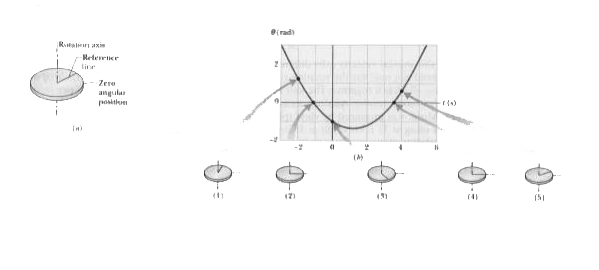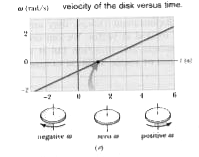The disk in Fig. 10-5a is rotating about its central axis like a merry-go-round. The angular position θ(t) of a reference line on the disk is given by
θ=−1.00−0.600t+0.250t2,
with t in seconds, θ radians, and the zero angular position as indicated in the figure.
(a) Graph the angular position of the disk verus time from t = -3.0 s to t = 5.4 s. Sketch the disk and its angular position reference line at t = -2.0 s, 0 s, and 4.0 s, and when the curve crosses the t axis.
(b) At what time tmin does θ(t) reach the minimum value shown in Fig. 10-5b? What is that minimum value?
(c ) Graph the angular velocity ω of the disk versus time from t = -3.0 s to t = 6.0 s. Sketch the disk and indicate the direction of turning and the sign of ω at t = -2.0 s, 4.0 s, and tmin.
(d) Use the results in parts (a) through ( c) to describe the motion of the disk from t = -3.0 s to t = 6.0 s.
(a) The angular position of the disk is the angular position θ(t) of its reference line, which is given by a function of time t. So we graph, the result is shown in Fig.
Calculations: To sketch the disk and its reference line at a particular time, we need to determine θ for that time. To do so, we substitute the time. For t = -2.0 s, we get
θ=−1.00−(0.600)(−2.0)+(0.250)(−2.0)2
= 1.2rad=1.2rad360∘2πrad=69∘.
This means that at t = -2.0 s the reference line on the disk is rotated counterclockwise from the zero position by angle 1.2 rad = 69∘ (counterclockwise because θ is positive). Sketch 1 in Fig. shows this position the reference line.
Similarly, for t = 0, we find θ=−1.00rad=−57∘, which means that the reference line is rotated clockwise from the zero angular position by 1.0 rad, or 57∘, as shown in sketch 3. For t = 4.0 s, we find θ=0.60rad=34∘. Drawing sketches for when the curve crosses the t axis is easy, because then θ = 0 and the reference line is momentarily aligned with the zero angular position.

(b) To find the extreme value of a function, we take the first derivative of the function and set the result to zero.
Calculations: The first derivative of θ(t) is
dθdt=−0.600+0.500t
Setting this to zero and solving for t give us the time at which θ(t) is minimum:
tmin=1.20s.
To get the minimum value of θ, we next substitute tmin into Eq. finding
θ=−1.36rad≈−77.9∘.
This minimum of θ(t) corresponds to the maximum clockwise rotation of the disk from the zero angular position, somewhat more than is shown in sketch 3.
( c) From the angular velocity ω is equal to dθ/dt as given in Eq. So, we have
ω=−0.600+0.500t.
The graph of this function ω(t) is shown in Fig. Because the function is linear, the plot is a straight line. The slope is 0.500 rad/s2 and the intercept with the vertical axis is -0.600 rad/s.
Calculations: To sketch the disk at t = -2.0 s, we substitute that value into Eq., obtaining
ω=−1.6rad/s.
The minus sign here tells us that at t = -2.0 s, the disk is turning clockwise.
Substituting t = 4.0 s into Eq. given us

The implied plus sign tells us that now the disk is turning counterclockwise.
For tmin, we already known that dθ/dt=0. So, we must also have ω=0. That is, the disk momentarily stops when the reference line reaches the minimum value of θ in Fig. as suggested by the center sketch in Fig. On the graph of ω versus t in Fig. this momentary stop is the zero point where the plot changes from the negative clockwise motion to the positive counterclockwise motion.
(d) Description: When we first observe the disk at t = -3.0s, it has a positive angular position and is turning clockwise but slowing. It stops at angular position θ=−1.36 rad and then begins to turn counterclockwise, with its angular position eventually becoming positive again.
Topper's Solved these Questions
- RIGID BODY DYNAMICS - IBOOK - RESNICK AND HALLIDAYCHAPTER - RIGID BODY DYNAMICS - IEXERCISE - CHECKPOINT
18 Videos
- RIGID BODY DYNAMICS - IBOOK - RESNICK AND HALLIDAYCHAPTER - RIGID BODY DYNAMICS - IEXERCISE - PROBLEMS
100 Videos
- RELATIVITYBOOK - RESNICK AND HALLIDAYCHAPTER - RELATIVITYEXERCISE - PRACTICE QUESTIONS (Integer Type)
5 Videos
- RIGID BODY DYNAMICS-IIBOOK - RESNICK AND HALLIDAYCHAPTER - RIGID BODY DYNAMICS-IIEXERCISE - PRACTICE QUESTIONS (Integer Type)
2 Videos
Similar Questions
Knowledge Check
The angular position of a line of a disc of radius r = 6cm is given by θ=10−5t+4t2 rad , the average angular velocity between 1 and 3s is
Aπrad s−1B11rad s−1C22rad s−1D5.5rad s−1If the equation for the displacement of a particle moving on a circle path is given by, θ=2t2+0.5 where, θ is in radian and t is in second, then the angular velocity of the particle after 2 s is
A8rads−1B12rads−1C24rads−1D36rads−1The angular displacement of a particle is given by θ=t3+2t+1, where t is time in seconds. Its angular acceleration at t=2s is
A14rads−2B17rads−2C12rads−2D9rads−2
A point on a body performing pure rotation is 10cm from the axis of rotation of body. Angular position of the point from reference line is given by θ=0.5e2t, where θ is in Radian and t in second. The acceleration of the point at t=0 is
View SolutionThe angular position of a swinging door is described by θ=5+10t+20t2. Determine the angular position, angular speed and angular acceleration at t=2s.
View SolutionIf the equation for the displacement of a particle moving on a circle path is given by, θ=2t2+0.5 where, θ is in radian and t is in second, then the angular velocity of the particle after 2 s is
View SolutionThe angular position of a point on a rotating wheel is given by θ=2.0+4.0t2+2.0t3, where θ is in radians and t is in seconds. At t = 0, what are (a) the point's angular position and (b) its angular velocity? ( c) What is its angular velocity at t = 3.0 s? (d) Calculate its angular acceleration at t = 4.0 s. (e) Is its angular acceleration constant?
View SolutionIf the equation for the displacement of a particle moving in a circular path is given by (θ)=2t3+0.5, where θ is in radians and t in seconds, then the angular velocity of particle after 2s from its start is
View Solution
